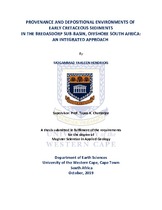| dc.description.abstract | Southern offshore basins of South Africa are well known as potential provinces of hydrocarbon exploration and production. The complex nature of the Bredasdorp sub-basin’s syn-rift architecture (transform fault system) can have adverse effects on reservoir distribution due to periodic local and regional uplift of horsts and grabens. This present investigation focusses on an integrated approach of the 1AT1-V horizon or early Cretaceous sediments in the Bredasdorp sub-basin to identify the depositional environment and provenance of these sediments as well as their role in regionally complex compositional heterogeneities associated with the late stage rifting of Gondwana break-up.
An integrated seismic, sedimentological (including petrography and geochemistry) and ichnologic analysis of the 1AT1-V horizon sediments showed an overall lower regressive element complex assemblage set and an upper transgressive element complex assemblage set that occurred as a >120m thick succession. The analysis identified a mixed-energy deltaic succession followed by an estuarine succession. The 1AT1-V interval (late syn-rift) consisted of nine sedimentary facies associations (and associated petrofacies) on a dipslope setting with variations occurring along the strike and the downdip depositional slope areas. Two overall sequences were identified as a lower regressive and upper transgressive sequence (Element complex assemblage sets). The regressive sequence consisted of middle to distal delta front lobe fringes, hyperpycnal event beds (sourced from basement highs), offshore migrating tidal bars (and associated inter-bar regions), distal mouth bars, terminal distributary channels (and associated inter-terminal distributary regions). The distal delta plain to proximal delta front consisted of interdistributary bays, distributary channels, crevasse splay sub-deltas, mouth bars, tidal flats and offshore embayments. In the laterally isolated depocenter, these deposits also consisted of basement high slopes with upliftment of the basement highs leading to proximal/central embayment to regressive shoreface/foreshore environments. These sequences consisted generally of low diversity and intensities (impoverished abundances) of trace fossils. The paleoclimate inference from this sequence indicates a humid climate with intermediate degrees of weathering intensities (possibly fluctuating arid-humid conditions). The transgressive sequence consisted of estuarine sedimentation with the occurrence of tidal sand ridges and compound dune fields, embayment facies and tidal bars. These sequences consisted of relatively higher ichnodiversities and intensities than their relative regressive sequences. The paleoclimate inference during these times consisted of more arid to semi-arid settings with low degrees of weathering in the source terrain. Local tectonic upliftment and subsidence, with exposed basement highs, gave rise to differential process regimes (tidal, wave and fluvial) and hence depositional facies in the diachronous updip/downdip areas (spatial) and within-stratigraphic (temporal) variations. There are several modern analogues that are similar to the 1AT1-V horizon sequence and they are the Mahakam, Ganges-Brahmaputra, Po, Burdekin deltaic and Satpara lake environments Compaction and dissolution diagenetic features as well as transportation were responsible for the major compositional heterogeneities concerning the reservoir quality and distribution. Proximal and distal sources were identified with first cycle and polycyclic sediments being deposited in the northern and southern part of the basin during the late stages of rifting in the Bredasdorp sub-basin.
The provenance lithology has been identified as recycled sedimentary rocks (and their meta-equivalents) with an ultimate source terrain that was largely felsic in nature (Cape granite suite). The northern part of the studied section is suggested to have received sediments from the main metasedimentary rocks of the Cape fold belt (including the Table Mountain Group and Bokkeveld Group) whereas the southern sections received more sediments from the basement highs (recycled Malmesbury Group (and Pre-Cape sediments) and Cape granite suite), which is further supported by seismic data. Provenance analysis revealed that the Cape Fold belt (most recent collision) was possibly a provenance terrain but overprinting of several collisions are also acknowledged. The tectonic setting was envisaged to be of a rifted margin during the break-up of Gondwana. This compositional heterogeneity due to facies and provenance-related terrains had major consequences to the reservoir quality and distribution from the northern part to the southern part of the studied section | en_US |

